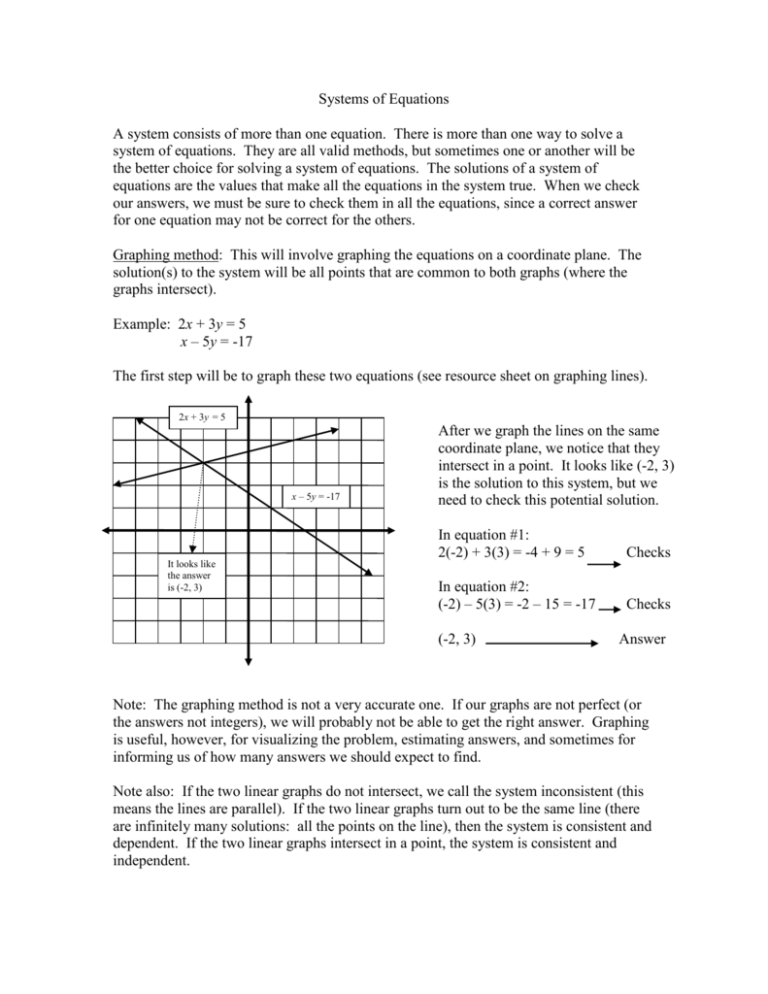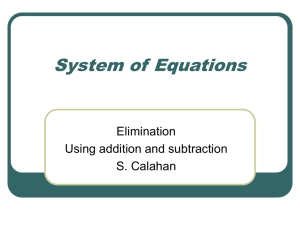Systems of Equations
advertisement

Systems of Equations A system consists of more than one equation. There is more than one way to solve a system of equations. They are all valid methods, but sometimes one or another will be the better choice for solving a system of equations. The solutions of a system of equations are the values that make all the equations in the system true. When we check our answers, we must be sure to check them in all the equations, since a correct answer for one equation may not be correct for the others. Graphing method: This will involve graphing the equations on a coordinate plane. The solution(s) to the system will be all points that are common to both graphs (where the graphs intersect). Example: 2x + 3y = 5 x – 5y = -17 The first step will be to graph these two equations (see resource sheet on graphing lines). 2x + 3y = 5 x – 5y = -17 It looks like the answer is (-2, 3) After we graph the lines on the same coordinate plane, we notice that they intersect in a point. It looks like (-2, 3) is the solution to this system, but we need to check this potential solution. In equation #1: 2(-2) + 3(3) = -4 + 9 = 5 Checks In equation #2: (-2) – 5(3) = -2 – 15 = -17 Checks (-2, 3) Answer Note: The graphing method is not a very accurate one. If our graphs are not perfect (or the answers not integers), we will probably not be able to get the right answer. Graphing is useful, however, for visualizing the problem, estimating answers, and sometimes for informing us of how many answers we should expect to find. Note also: If the two linear graphs do not intersect, we call the system inconsistent (this means the lines are parallel). If the two linear graphs turn out to be the same line (there are infinitely many solutions: all the points on the line), then the system is consistent and dependent. If the two linear graphs intersect in a point, the system is consistent and independent. Substitution method: This method is purely algebraic in nature. It involves solving one of the equations for one of the variables. Then we will take this expression for that variable and substitute it into the other equation. Let’s solve a system with the method. Example: 3x + 6y = 1 x – 12y = 19 x 12 y 19 x 19 12 y 3x 6 y 1 3( 19 12 y ) 6 y 1 57 36 y 6 y 1 57 42 y 1 42 y 56 56 y 42 4 y 3 x 12 y 19 4 x 12 19 3 x ( 16 ) 19 First we need to solve one of the equations for one of the variables. We chose the second equation; since it doesn’t have a coefficient on the x-term, it will be fairly easy to solve for x. Now, we substitute that expression for x into the other equation. You’ll notice that our new equation only has one variable in it. Solve this equation for that variable (y in this case). After finding a value for one of the variables, we can take that value and substitute it into one of the original equations. This process is sometimes called “back-solving.” Now we get a new equation with only one variable. Solve this equation for that variable (x in this case). x 16 19 x3 4 3, 3 Answer. First equation: Second equation: 4 3 12 19 3 3 4( 4 ) 19 3 16 19 19 19 We can check this answer by substituting the values for x and y in our original equations. Remember that our solution has to work in both of the equations. We see here that this solution is correct since it works in both of the equations. Note: If during the process of solving a system of equations with the substitution or elimination methods, you get a contradiction, like 0 = 3, it means that the system is inconsistent and there is no solution to it. If during the process of solving a system (not when checking solutions) you get an identity, like 6 = 6, then the system is dependent and there are infinitely many solutions. If the equations are linear and dependent, then the solution contains all the points that lie on the line. Elimination method: Like the substitution method, this is also an algebraic approach. The elimination method will use the addition property of equality (and often multiplication property of equality) to combine two equations and “eliminate” either the x or y term. The new equation will only have one variable and you can proceed to solve this equation for that variable. Then you can “back solve” for the other variable. We will solve a system using this method. Example: 4x – 3y = 5 x – 6y = 8 2 4 x 3 y 5 2 8 x 6 y 10 x 6y 8 8 x 6 y 10 7 x 0 2 7 x 2 x 2 7 x 6y 8 2 6y 8 7 2 42 y 56 In order to eliminate one of the variables, we must get either the x or y terms in the two equations to be equal and opposite. We will use the multiplication property of equality to make the coefficients of the y-terms equal but opposite. This means we must multiply the first equation by (-2). Note: We could’ve multiplied the second equation by (-4) and eliminated the x-terms. Note also: When making the coefficients equal but opposite, it is wise to find the least common multiple for the two coefficients. This will give us smaller numbers to deal with. Now, we add our new equation to the second equation. The addition property of equality allows us to do such an operation. Notice that when we add these equations, the sum of the y-terms is zero. We are left with an equation in x only. After solving for x, we use this value and one of our original equations to “back solve” for y. 42 y 54 54 9 42 7 2 9 , 7 7 y Answer. First equation: Second equation: 2 9 4 3 5 7 7 8 27 5 7 7 35 5 7 55 28 9 6 8 7 7 2 54 8 7 7 56 8 7 88 We can check this answer by substituting these values for x and y in our original equations. Remember that our solution has to work in both of the equations. We see here that this solution is correct since it works in both of the equations. Note: When solving systems with more than two unknowns by substitution or elimination methods, make sure to incorporate all the equations. For instance, in a system of three equations in three variables, you may use equations 1 and 2 to eliminate one variable. Then, you should use equation 3 and either 1 or 2 to eliminate the same variable. This will give you two new equations with only two unknowns, which you can then solve like the above examples. We will solve a system of three equations next. We’ve been solving systems with only two unknowns in two equations, but elimination and/or substitution can be used for larger systems. Let’s solve a system with three unknowns using these methods. First we use the 2nd and 3rd equations to eliminate the z-terms. Example: 2x – 4y + 3z = -3 -3x + 8y + z = -5 This gives us an equation with x and 5x – 12y – z = 8 y-terms only. -3x + 8y + z = -5 Since we haven’t used the 1st +(5x – 12y – z = 8) equation yet, we need to incorporate 2x – 4y + 0 = 21 it. We will use the 1st equation and 2x – 4y = 3 the 3rd equation to eliminate the z3(5x – 12y – z) = 8 (3) terms again. 15x – 36y – 3z = 24 2x – 4y + 3z = -3 We multiply the 3rd equation by 3 so +(15x – 36y – 3z = 24) that the z-terms will be eliminated 17x – 40y + 0 = 21 when we add it to the 1st equation. 17x – 40y = 21 2x – 4y = 3 17x – 40y = 21 This gives us another equation with x and y-terms only. -10 (2x – 4y) = 3 (-10) -20x + 40y = -30 Now we have a new system with only two variables. We can solve this just like the examples discussed above. Because 40 is a multiple of 4, it will probably be easiest in this case to use elimination. 2(3) – 4y = 3 6 – 4y = 3 -4y = -3 We multiply the top equation by -10, and then add it to the bottom equation to eliminate the y-terms. -20x + 40y = -30 +(17x – 40y = 21) -3x = -9 x=3 2x – 4y = 3 y= 2x – 4y + 3z = -3 3 4 3 + 3z = -3 4 2(3) – 4 6 – 3 + 3z = -3 3z = -6 z = -2 3 3, ,2 4 Once we have one of the variables, we will use this value to back solve for another. We use the fact that x = 3 and one of our equations with only x and y variables in it to find y. Two of the three variables are known, so we use one of the original equations to find the last variable. Our answer is an ordered triple (x, y, z). The check is left up to you.








